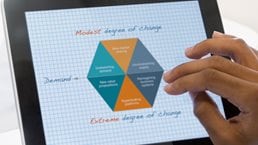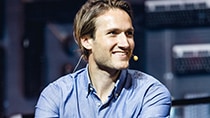Niklas Östberg, an energetic 35-year-old Swede, is the CEO and cofounder of Delivery Hero. Based in Berlin and financed with venture-capital money, the company is built around an online platform that matches restaurants with hungry customers. Delivery Hero has grown to operate today in 33 markets across five continents, processing 14 million takeout orders each month and offering customers recommendations, as well as peer reviews of restaurants.
With a valuation of $3 billion, Delivery Hero is also one of about 170 “unicorns”: start-ups with valuations above $1 billion. Given the number of new companies that crashed when the turn-of-the-century tech bubble burst, many executives and investors have cast a skeptical eye on the unicorn phenomenon. Östberg recently discussed with McKinsey’s Thomas Schumacher and Dennis Swinford the start-up landscape, the importance of innovation grounded in data, and his company’s role as a “disruptor of an inefficient restaurant industry.”
The Quarterly: Valuations of pre-IPO tech companies have come under scrutiny lately, particularly the emergence of so-called unicorns. What’s going on, in your perception?
Niklas Östberg: I’m sure a number of those unicorns shouldn’t be unicorns. As always, earlier-stage businesses come at a higher risk. But I am also sure that the next Google or Apple is among them—and if only one or two of the current pool of unicorns get to that level, it justifies their valuations, collectively, from an investor point of view.
But a lot has changed in the 15 years since the tech bubble of 2000. At that time, many valuations were based on what the future might look like, particularly in the Internet space, rather than on the returns a business could demonstrate. The supposition was that the world was changing and would probably change for the better as people went online. And although people did eventually go online, that happened much more slowly than predicted.
Today, there’s no doubt that online and Internet businesses are taking over. Some of the biggest businesses in the world, including Facebook, Amazon, Google, and Apple, are solidly grounded in the new world of technology. A lot of other companies also have large, tangible revenue growth and earnings. They don’t buy users or customers with the hope of making money when, maybe, those users eventually change their behavior. Delivery Hero, too, generates a lot of revenue—and earns a lot of profit in many markets. So valuations don’t depend on imaginary future earnings but on actual returns and EBITDA.1
The Quarterly: How does your business model work?
Niklas Östberg: We’re a place where users and restaurants meet. The core of our business is an online platform that allows us to map users to the restaurants around them. Users are attracted to the platform and become very loyal to it because it helps them identify which restaurants are available and which ones are good. It’s also convenient because they can pay online, review past orders, and chart their savings.
It’s a good model for restaurants, too. We channel more business to them, and they increase their orders. And because the variable cost of food is pretty low, adding incremental customers is pretty lucrative. A restaurant that serves 100 orders a day might not make a lot of profit, for example, but if it boosts that to 110 orders a day, it would make good profits. Boost that to 200 orders a day, and it will make loads of money. So restaurants want to be on our platform, and we charge them a fee for transmitting orders. If they decide they no longer want to be on the platform, customers can order from other restaurants.
Everything is automated and online, so our gross profitability per order is around 90 percent. That also comes back to why we want to grow—because if you have 90 percent gross profitability and low variable costs, the closer you get, in theory, to 90 percent net profit. This compels us to build scale to add those incremental users and get closer to that 90 percent EBITDA margin. In some markets, we have already reached over 60 percent.

Strategy in a digital age
Our series on developing corporate and business-unit strategies in a digitally disrupted world.
The Quarterly: Who are your competitors?
Niklas Östberg: The usual way of ordering food is to pick up the phone and call, so our biggest competitor is still the phone. And most people also still cook, though only some of them actually like doing it. So why shouldn’t we get the many who don’t like cooking? At a societal level, is it efficient for every little household to do its own cooking? For everyone to go to the supermarket and shop for groceries individually, versus buying groceries and preparing meals for 100 people at once? More and more, people don’t cook as long as they can get the healthy food they want when they want it. That’s our challenge, then—to improve the inefficiency of that industry, to make it more accessible and available.
The Quarterly: You’re talking about disrupting the entire social network of how people eat?
Niklas Östberg: I think we should, over the long term. Of course, you can’t do that all at once, but if you look over ten years, why not? Our focus is first to attract those customers who order by phone and then to keep attracting new customers by making the service better. Every small, incremental improvement takes us one step closer. And at some point, maybe we’ll have a service that’s so good, why would anyone cook?
The Quarterly: So if home cooks and the telephone are your major competitors, who really worries you?
Niklas Östberg: We do also have competitors in our own space. Uber, for example, and Amazon and Yelp have similar efforts under way. It’s a big space, so why wouldn’t they try? Even Facebook could enable online food ordering via chat bots, which could completely change the industry yet again. And, indirectly, guys like Facebook could become our competitors because they could connect to someone else who provides restaurant info to their chat bots. And Google, continuously offering better access to information, is already offering restaurant data, including restaurant menus. So if we don’t stay innovative and don’t stay the best and don’t offer access to the best and fastest food, then in the long term we are in trouble. That’s why we can never relax.
The Quarterly: Do the restaurants get more value out of this than just reaching more customers?
Niklas Östberg: We try to give them as much value as we can, and it’s part of our vision to do so. Besides attracting more customers, we reduce their operational costs, since they don’t need to have someone answering the phone, for example. We also provide them with a point-of-sale system replacing the cash register and we compile useful statistics. That will not only save some thousands of euros per year but also help them provide better food and service to their customers.
And while we expect to do more in the next year or so, we’re already able to tell restaurants which menu items are likely to work. We can say, for example, “it looks like there’s no one in your area providing a bacon burger. Why don’t you add a bacon burger to your menu?” We can say which dishes always bring customers back. Conversely, we can also tell which menu items draw customer complaints or have very low reorder rates. Customers order, but never return. Every time someone buys that dish, the restaurant loses a customer.
The Quarterly: Innovation is most successful when it disrupts what already exists. Who are you disrupting?
Niklas Östberg: I would say that we are a disruptor of an inefficient restaurant industry. We’re disrupting bad service, inefficient manual processes. We’re disrupting inefficiencies in how restaurants connect with customers—not every restaurant can build its own online food-ordering platform. We’re disrupting inefficiencies in delivery. It makes no sense for every small restaurant to try to have its own delivery fleet with its own drivers, given the cost of maintaining a fleet and coordinating deliveries. After all, if a restaurant five kilometers away delivers to someone in one place and then goes five kilometers in another direction to deliver to someone else, it’s expensive. It’s bad for the environment. And it’s bad for customers because it takes so long.
We’re also disrupting the inefficiency of a system that doesn’t serve the food customers want. If you were to ask people on the street, a lot of them would say, “I don’t like delivery because I don’t eat pizza” or “it’s just bad quality and bad food.” Combined, those inefficiencies raise costs and reduce quality.
The Quarterly: How are you using all the data you generate to improve your business?
Niklas Östberg: Big data should actually be big, meaning it should be available to the entire organization—especially at the front line of the business. That’s where companies make tens of thousands of decisions every day, some of which can be handled automatically. These can be very small things, like “shall we do this kind of promotion for our users?” “Is that a good channel for our advertising?” “How do we improve our relationship with a specific customer?” If a restaurant has very bad delivery on Sunday evenings, we can downgrade it on Sunday evenings. If the system detects fraud, we can trigger people to stop ordering.
We also monitor our restaurants to maintain relationships. We know, for example, that a restaurant is likely to cancel its contract if it starts contacting us more frequently or gets negative feedback from customers. The data automatically trigger a pop-up to one of our sales agents—“call this restaurant, see what’s wrong, and do what you can to help.” This involves decisions that are made both automatically and independently by sales agents, as long as they have the right information, and saves a lot of money.
The Quarterly: Do data also help inform investment decisions?
Niklas Östberg: Data help us to be a little faster at managing our investments. Say you make an investment with a one-to-ten probability that you’ll be right—but if you’re right, you’ll make a 100-to-1 return. That’s a very good investment to try. The problem is that if you’re wrong in nine out of ten cases, you need to have a very fast way of figuring that out. Then, when you do find the one investment with high returns, you can put a lot of money on it.
For example, while the main part of our offering is the online platform, we’ve also invested in separate businesses to handle delivery for independent restaurants. That is part of building up our logistics to enable a better service. Restaurants still do the cooking, naturally, but we track their orders. We offer quality assurance through metrics like user ratings and reorder rates. And we tell restaurants which dishes on their menus are good for delivery. We also make much more money on that—around €10 per order, less the cost of delivery.
For investments like that, we track the data and optimize performance, shutting them down quickly if it becomes clear they can’t meet our expectations. We spent nine months on an earlier delivery-space investment, based on a different concept and setup, for example. We did as much as we could to improve its performance and invested close to €10 million in the project. But it wasn’t meeting our expectations, so we shut it down and took the loss. Now, maybe we could have realized that sooner and lost just €6 million, but other companies might have dragged out the investment and spent €100 million on it. The point is, if you’re going to fail, you want to fail fast. You invest to validate or invalidate the concept and then shut it down if necessary.
The Quarterly: You appear to have a highly federated business model with a number of CEOs of individual delivery businesses. How does that work?
Niklas Östberg: Centralization is always more efficient, in a way, because you can do one thing and multiply it across units. On the other hand, giving people autonomy and authority and responsibility also has an amazing value. What rarely works is to be 100 percent one approach or the other. The trick is finding the right balance.
We give local CEOs autonomy and authority to encourage entrepreneurship—and they fight with blood and sweat to win in the market. But you have to set the rules of the game. And you have to set the culture of your company. That balance can be fragile. For example, if you set the wrong incentive scheme and you place autonomy at the local level, people are more likely to optimize for their incentive schemes rather than for their businesses. And, suddenly, you’re sitting there on a conference call wondering, “is this the right decision that he’s suggesting or is this the right decision for him?” And you don’t really know. That’s why, first of all, it’s important to find people with an owner mentality rather than a manager whose career and financial interests are the top priority. Then give them an incentive scheme that reflects ownership as closely as possible.
Finally, we’re a data-driven culture. Decisions based on data are the glue that holds us together. And if data are your starting point, then a CEO in Argentina, for example, can’t just argue that “we should do it this way because every Argentinian’s doing it this way.” We might not agree, but we can do the A/B testing and see what the data tell us. CEOs get the final decision, but if they can’t prove that their way is better and still do things their way, it’s a question of judgment. You can be wrong many times as long as you address the issue.
The Quarterly: If we look back in our imaginations five years from now—say, after an IPO or acquisition—what would have to happen for Delivery Hero to fail? And what must happen for it to justify its considerable valuation today?
Niklas Östberg: We’re in an economy that moves fast. It would be terribly dangerous to think that something can’t go wrong or that we can’t be disrupted. That could happen, especially if someone comes along with an innovation and we’re not already there. So we are always—and I think you have to be—on the edge of innovating and on the edge of moving fast. That’s what’s required of companies at our stage.
In terms of revenue, we’re in a good position. This is true even if I don’t argue that we can grow over 50 percent five years in a row, though I think we could; even if I don’t assume that we can improve our unit economics, though I think we will; and even if I don’t assert that we can increase our pricing, though I think we can. Today’s valuation is not built on some utopian assumption that the world will change and people will suddenly start ordering food in a certain way. People already order food online—and we have the data. We are the market leader in at least 25 markets. We have a business model that people like. And every second of every hour, we deliver 16 meals globally, hundreds of millions of orders a year. I think we’ve proved we can make a profit out of that.



